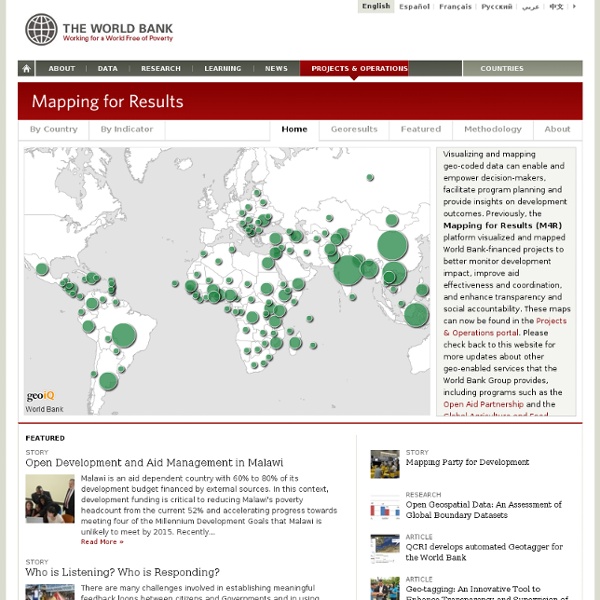



http://maps.worldbank.org/maps/
Map « Open Government Data This map is a starting point of mapping information around Open Government Data, initiatives, catalogues, competitions and events. This map is work in progress and not complete or comprehensive. The original source is from our friends at the semantic web company: Here is the original KML file Data and Statistics World Economic Outlook Databases (WEO) Updated Download time series data for GDP growth, inflation, unemployment, payments balances, exports, imports, external debt, capital flows, commodity prices. More International Financial Statistics (IFS) Open Development and Aid Management in Malawi Malawi is an aid dependent country with 60% to 80% of its development budget financed by external sources. In this context, development funding is critical to reducing Malawi's poverty headcount from the current 52% and accelerating progress towards meeting four of the Millennium Development Goals that Malawi is unlikely to meet by 2015. Recently, the country has experienced governance issues where huge amounts of public funds were fraudulently accessed by government officials. Together, these factors make transparency of public resources more important than ever.
iMENTORS: Taxpayer money and donor data under the microscope - News & Events Making information about aid spending easier to access, use and understand iMENTORS has opened its data to all unregistered users in its last six months of operation. It is important that donors provide information about the aid they give. item Description As part of the World Bank’s new Policy on Access to Information and building on the success of the Open Data initiative, the World Bank launched the interactive Mapping for Results (M4R) platform in October 2010. The initiative visualizes the location of World Bank projects to better monitor project and impact on people; to enhance transparency and social accountability; and to enable citizens and other stakeholders to provide direct feedback. For the 2011 World Bank Annual Meetings, the World Bank has released maps of project locations at the sub-national level for all International Bank for Reconstruction and Development (IBRD) and International Development Association (IDA) countries.
Infographic Of The Day: Bloomberg And Frog Turn Raw Data Into Branding Bloomberg is a sprawling, multi billion-dollar enterprise, which creates a distinct problem if you’re trying to explain what the company actually does. They do lots of things, ranging from law research to sports research for team managers to, of course, stock-market data crunching. "Many people have a single association with Bloomberg, as a wire service or a market-data provider," says Jen Walsh, Bloomberg’s head of digital marketing. "We wanted our website to shine a light on other aspects of the business." Walsh sounds like she’s describing a typical corporate homepage, but she tapped frog to create something altogether different: A vast, infinitely scrolling wall of real-time data. The idea is that Bloomberg, in all of its businesses, provides data and information.
Malawi - Resources - Malawi Socio-Economic Database (MASEDA) Malawi Socio-Economic Database (MASEDA) The Malawi Socio-Economic Database (MASEDA ) is the first comprehensive and up-to-date socio-economic database on the situation of human development in Malawi for use by government institutions, the donor community and civil society counterparts. MASEDA was created by UNICEF and the National Statistics Office in collaboration with Malawi’s development partners. It was developed to enable the civil society organisations, international organisation, government departments, academic institutions as well as policy makers to have access to the information for their own purposes pertaining to socio-economic development in Malawi. Version 3.0 contains information on each sector of the economy that is critical to Malawi's socio-economic development and poverty reduction and contains data for a total of 245 indicators.
Latest As I mentioned in my previous post, our collaboration with the Sabeti Lab is aimed at creating new visual exploration tools to help researchers, doctors, and clinicians discover patterns and associations in large health and epidemiological datasets. These tools will be the first step in a hypothesis-generation process, combining intuition from expert users with visualization techniques and automated algorithms, allowing users to quickly test hypothesis that are “suggested” by the data itself. Researchers and doctors have a deep familiarity with their data and often can tell immediately when a new pattern is potentially interesting or simply the result of noise. Visualization techniques will help articulate their knowledge to a wider audience. This time around I will describe a quantitative measure of statistical independence called mutual information, which is used to rank associations in the data. -log 1/1000 = log 1000 = 6.9